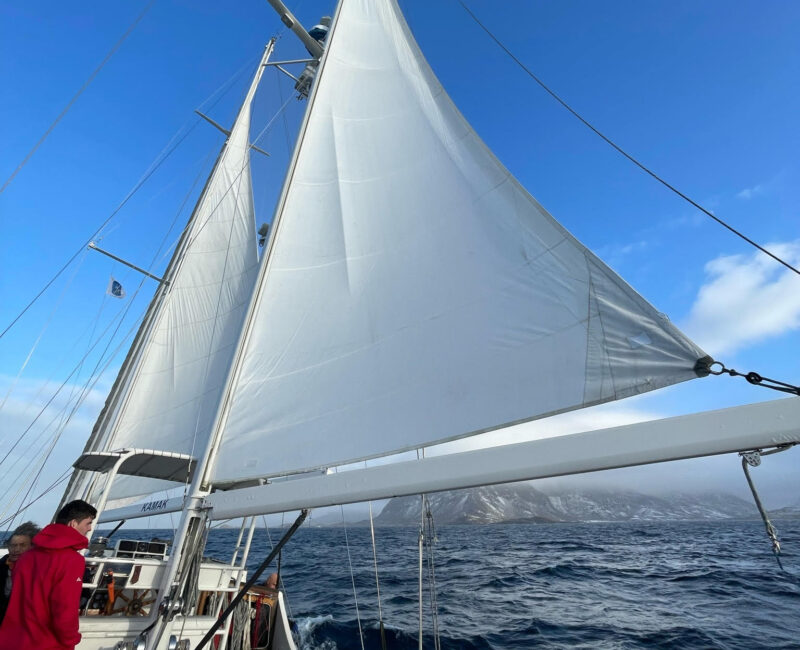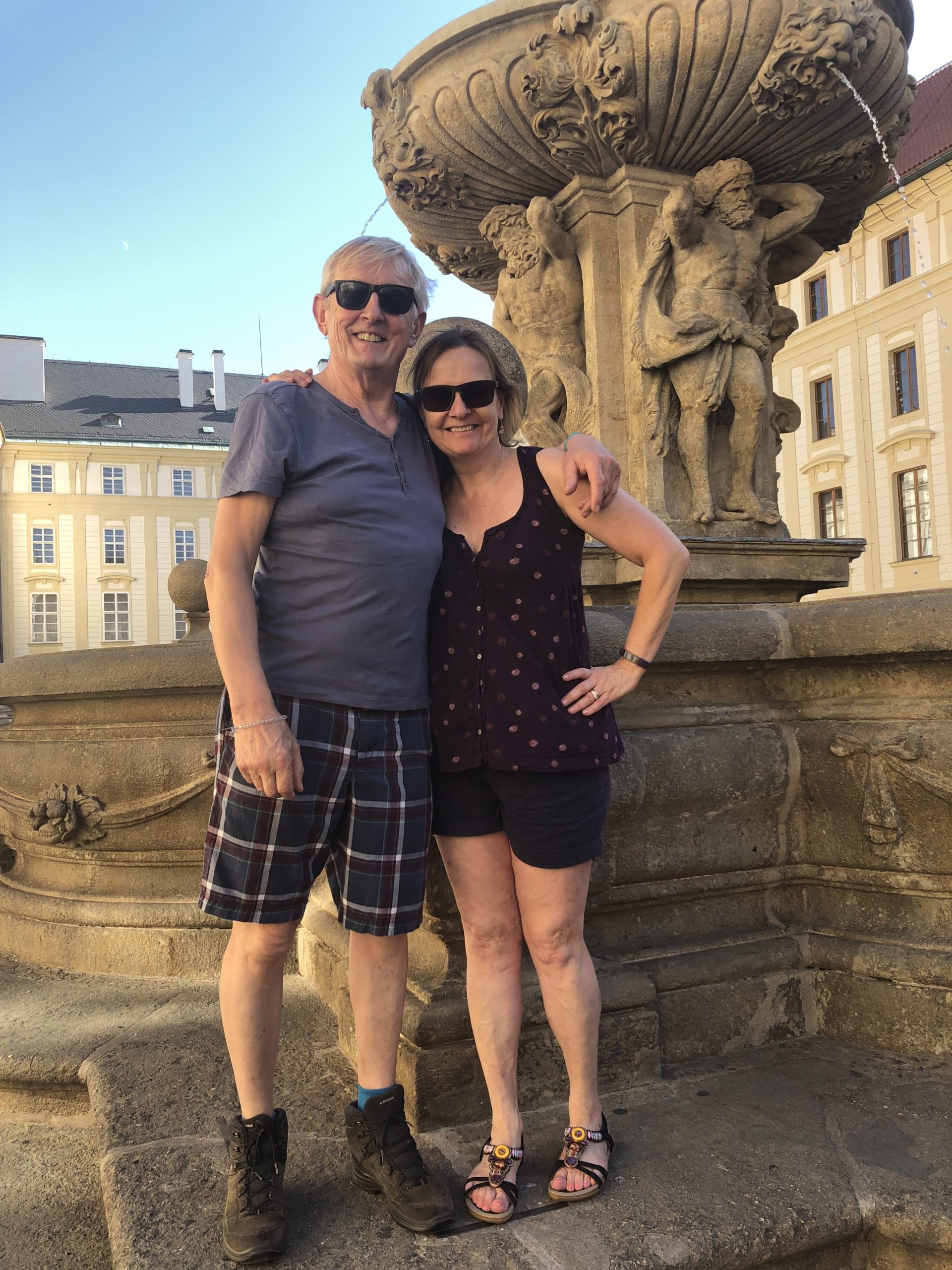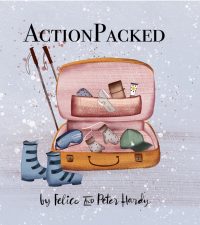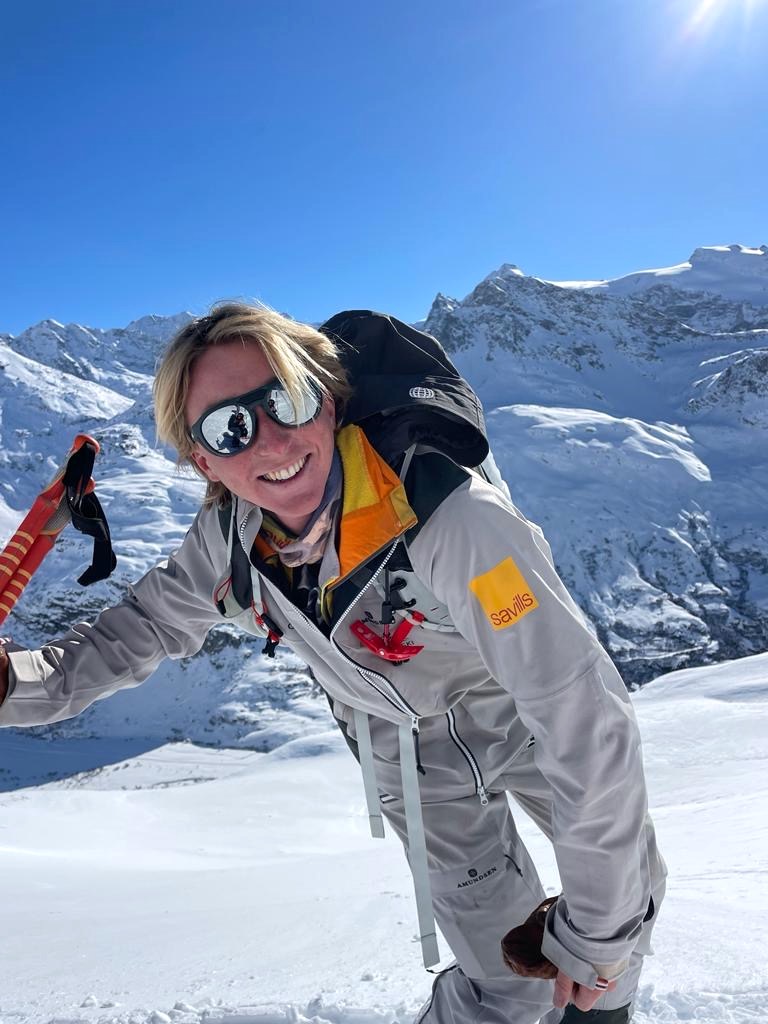
Rory Dixon
Peter Welcome to our travel podcast. We’re specialist travel writers, and we’ve spent half a lifetime exploring every corner of the world.
Felice So we want to share with you some of our extraordinary experiences and the amazing people we’ve met along the way.
Peter This week, we’re exploring the delights of ski-touring from a boat in Norway and heli-skiing from a superyacht in Greenland. To find out about both, I went to the French Alps to catch up with snow entrepreneur, Rory Dixon.
So Rory Dixon, you’re a British-born ski instructor based in Val d’Isère in the French Alps, but you’re a lot more than that. Not content with teaching skiers, you’re passionate about taking your clients on what you describe as ‘life-changing adventures’ – ski-touring trips to distant corners of the world that will be burned on their memories for the rest of their lives.
Now you have a sporting pedigree that it would be really hard to equal. Your grandfather is Robin Dixon who, with Tony Nash, famously won Olympic gold in the two-man bobsleigh at Innsbruck in 1964. Your mother is equestrian, Karen Straker, who competed in no less than four Olympic Games, winning silver in team eventing at Seoul in 1988, along with World team silver in 1990 and World Team Gold in 1994. But it’s not bobsleigh or horses that have gripped your life – it’s skiing.
I should explain that for the last 28 years, I’ve been involved in running personal performance courses for skiers in Val d’Isère and neighbouring Tignes at the very start of each season. And the idea is to help provide our clients with the transition from intermediate to advanced levels to get them off the so-called intermediate plateau. Frankly, an impossibility without expert tuition.
I hasten to add that the teaching is not done by me, but by my old friend and guru, Pat Zimmer, a former French ski racer much revered in the international ski industry. Now, Pat added Rory to our small team of expert instructors three years ago, which says a lot about you both as a professional skier and as a communicator. But as you’ve been telling me, you’ve got a thirst for adventure that goes way beyond spending seasons as a teacher in the Alps.

Photo: © Rory Dixon
Rory I grew up skiing, and it’s a part of my life. It always has been a huge part of my life ever since the age of eight. It’s all I wanted to do. But when I got into ski racing, I spent all my time, all my waking hours, thinking about skiing and devoted to it. And then when I stopped ski racing, the natural thing for me to do was…I came straight out to the Alps because I couldn’t see myself not skiing and not being in this environment. I actually fell in love with skiing in a very different way: I fell in love with the mountains and going on adventures in the mountains, and also sharing experiences with people in this environment as well, which is a big part of it.
Peter Now you chose the hard road to getting your top international qualifications, rather than going down the British BASI route. You did it through the French system, the ESF. Not always easy, I suspect. You had to first of all, learn to speak French fluently and, presumably, learnt how to put up with a lot of flak from your fellow trainees who weren’t always sure about having what you might describe as a post-Brexit rosbif in the nest with them.
Rory Definitely. It wasn’t an easy start. It was quite funny actually. I asked the director of the ESF for a job and he laughed and said, why not if you can do the test? And I came back two weeks later having done said ski race test. He didn’t know I was a ski racer, and I put the piece of paper on his desk. And that was the fabled test technique, which is the big barrier to entry to working as a ski instructor in France.
It’s a ski race. They send down a professional, three professional, ski racers. If you want to qualify, you have to be within a certain percentage of their time and it’s normally less than 5 to 10%. But just to put that into perspective, on the day I did it, I think there were about 120 competitors that turned up to do it, and there were only four of us that got it.
I came back and gave him the piece of paper and sure enough, he gave me the job. But that wasn’t the end of it, you know. Working as a young Brit in a big French organisation like that very quickly learnt that the only way I would even remotely fit in was to try and make a big effort to learn their language, and also to get qualified. So that’s what it motivated me to do. To be honest with you, I can’t thank them enough, ironically, for the hard time they gave me, it pushed me to improve and it pushed me to do everything I’ve come to do today.
Peter Away from the day job in the French Alps, last year you hit upon the idea of taking an international group of skiers ski-touring in Norway. How do you begin organising something like that?
Rory Well I must confess, the way I came about it was on social media. I saw another mountain guide that runs these trips up there, and I was just dreaming…ever since I saw these pictures on Instagram, I was just dreaming of going up there myself. I take a lot of clients off-piste. That’s my real passion and it’s something that I’ve become very passionate about. During Covid, I used it as an opportunity. I just went ski-touring and heli-skiing every day and just used it as an opportunity to recce the Alps.
So for my age I’ve got a huge amount of experience relative to the amount of years I’ve been out here ski instructing. I spent a whole year just recce-ing the Alps and skiing and training with a mountain guide to do all of these exams.

Photo: © Rory Dixon
I discovered this passion and then I saw this fellow guide that was running these trips, and I simply called him and said, ‘I want to do it. How do I do it?’ He really, very simply gave me the phone number of the chap who owned a yacht up there and said:
‘If you want to run a trip up there, Rory, you need to book this boat. You need to pay him a deposit in order to book it. You need to then book another guide who knows the area and can help you with the trip, and then you need to find the clients to fill it.’
And so that’s what I did. I wrote down on the back of a piece of paper the costs, including chartering the boat and the other guide and my own costs. I divided it by the number of spaces. I rang the owner. I put my own money down as the deposit with the confidence that I would fill it. It was a bit of a long shot, but I managed to pull it off. What it’s done is it’s just given me real inspiration to keep running these trips, and trips like it, and keep exploring.
Peter Tell us first of all about your trip and how you did it and what you actually did. What’s the boat like?
Rory So very simply, an outline: we chartered an 85 foot sail yacht, went up into the fjords up on the northwest coast of Norway with a group of nine.

All aboard. Photo: © Rory Dixon
Peter I must interrupt you here. I don’t really see the connection between boats and skiing. Tell us about that?
Rory I’m an avid sailor myself. I work on yachts in the summer, and the fantasy of combining the two was always something that excited me. But also on a practical note, simply to get access to these remote locations, these mountains on the coast, is very, very, very difficult. Actually using a yacht as a vessel to be able to gain access to these areas is one of the best ways to do it. And then the skiing in that environment is obviously then doubling up. It’s something that sort of sounds like a fairytale idea, really, to take a yacht and to go skiing from it.
Peter So what’s the practical way of doing this? Tell us about how you get off the boat?
Rory So we go up there on the yacht into these fjords, and the mountains are either side, drop the anchor and get all suited and booted. Clamber into this rib with a little outboard engine on, and that takes us ashore.
The way it actually drops you ashore is quite funny, really. It has to get enough speed up that it comes in with quite a bit of speed, and he just lifts up the propeller so it doesn’t hit the floor as he comes in, and then you basically just pile in to the snowy shoreline. Everybody then clambers out the front, handing each other skis, and as you will climb out the boat, the little rib becomes lighter and then drifts off, goes back to the mothership, and you’re left there in a big pile of snow with all your ski equipment. Well, then it’s getting ready to go skinning and ski-touring up. And that basically includes putting skins on your skis.
Peter So tell us about skins. What’s involved?
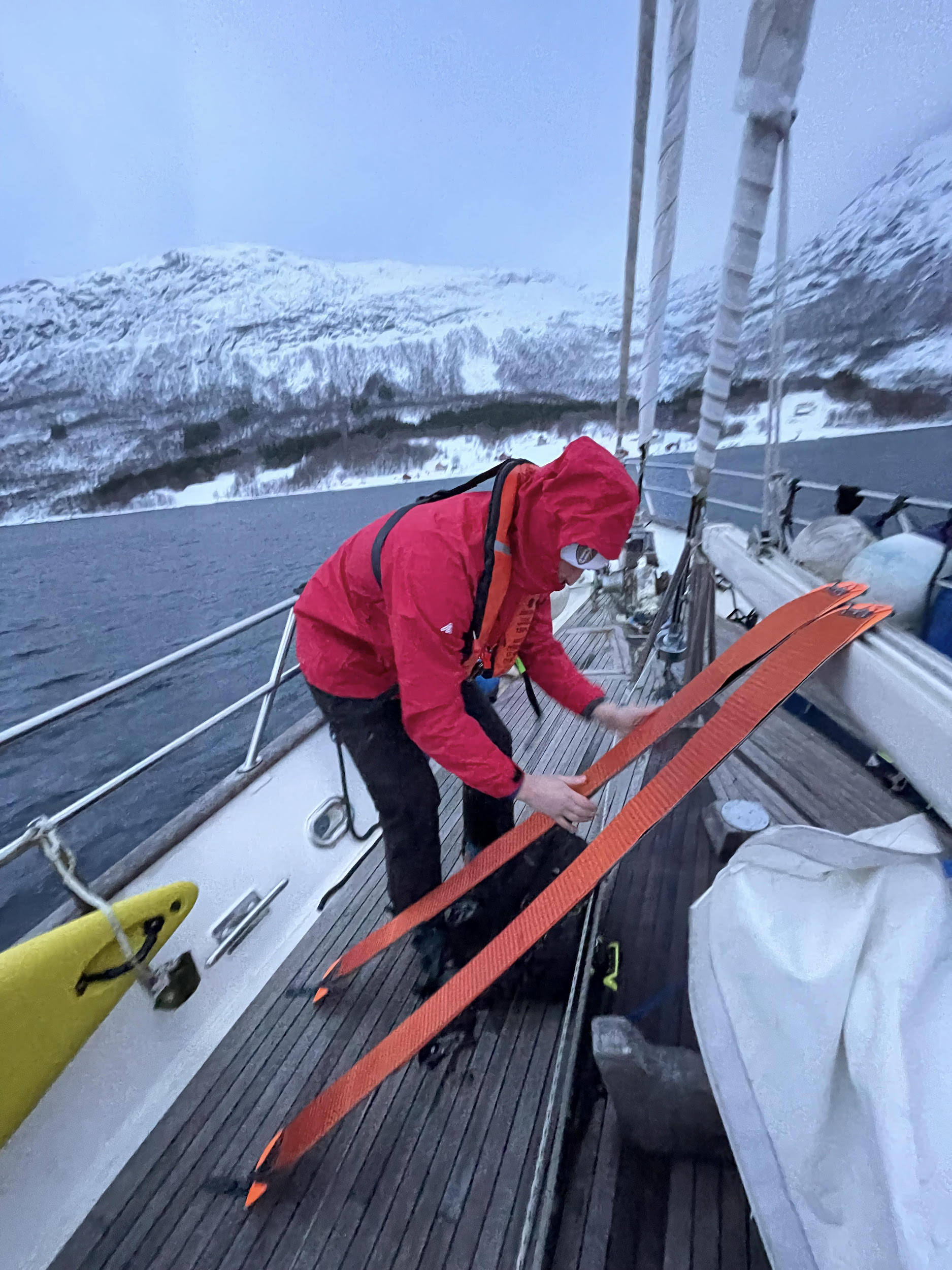
Getting skins on. Photo: © Rory Dixon
Rory Well, skins – hence the name – used to be when they were first invented, quite literally seal skin, the fur on the outside and you would stick them to the bottom of your skis. The idea is that as you slide your ski up, the hairs lay in one direction, and then as you stand on it, they grip, which basically allows you to be able to walk up a slope with your skis on your feet. Now they’ve got modern materials that they use, easy to stick on and more effective at gripping than normal animal hair. But it’s the same idea. You basically stick these skins to the bottom of your skis, and then you clip your bindings onto your boots and you walk up the mountain. Once you’re at the top, you then ski down.
Peter If something goes wrong with your gear, in such a remote environment, you can’t of course, like in the Alps, go to a ski shop and get a binding fixed. How do you cater for that sort of thing?
Rory It’s funny you say that because we actually have to pack a lot of extra equipment. Going up into the this environment, I had a chat with the guide who spends a huge amount of time up ski-touring up in Norway. He explained to me that you don’t just need to provision in your rucksack for what you normally would in the Alps, which is first aid kits and food and radios, but you also need to take stuff just in case something goes wrong. You need to be independent in all scenarios and the dangerous scenarios are really equipment failure.
We packed all sorts of stuff in the bag, and on the first day we had someone break their skis, and luckily I’d had this brief and packed some industrial ratchet straps. I managed to strap this ski to my foot and then let the client ski down on my skis. But as the French say, there’s a great expression which is au bout du monde, which means the end of the world, or the edge of the world. And that’s really where you are, and it’s very important to be aware of that. You’re a long way from civilisation and you need to be self-sufficient. You need to maintain a safety margin, and you also need to be able to correct and have systems in place that you can deal with it when it goes wrong.

Broken ski. Photo: © Rory Dixon
Peter So, Rory, tell us about the actual skiing. What’s involved? How difficult is it?
Rory Once you’ve walked up, and I don’t want to put people off, the prospect of walking up mountains, because it’s really not as crazy as it may seem, the walking up. You’re ski-touring and actually, the goal with ski-touring is to take the easiest route up. Ninety percent of the time you end up walking a further distance, in order to take an easier route up.
What you’re trying to do ultimately is meander up the shoulder of a hill and get to the top of the mountain. And once you’re up there, so the stopping along the way, on the way up, cups of coffee and chats and photographs. It’s not a rush. It’s not a race. It’s not a sprint. It’s a walk up a hill, effectively. But you do arrive at the top of the mountain a few hours later, believe it or not, and when you do get up there, then you then take these skins off, get yourself ready to ski down and do just that.
It’s the most surreal experience because your horizon is all the sea, and there’s mountains that you’re skiing down and also on the horizon. It’s sort of a combination that you simply have never, ever experienced before, seeing an ocean lapping up at the foot of a mountain whilst you’re skiing down it.
Peter Can it be quite steep?
Rory The gradient is very much up to what the guides see is suitable for the conditions and also the level of the group. There is a complete mix of terrain. The topography of the Norwegian coast is that they have these quite mellow slopes that come out of the sea sometimes, and then go up into very steep mountains, and further north there are very steep mountains with mellow slopes further inland.
But ultimately, if there’s a group that have a good ability and the conditions are safe, then we can then we can ski as steep and as high as everybody’s up for. Equally, if there are people that are feeling a bit tired and have slightly less confidence, then we can take it quite easy. So actually, on the trip we ran this year, we had a real mix. Everybody was good at skiing.
Peter What sort of age group do you have?
Rory A complete mix. We had 22 to 72 was the spread, and five nationalities and it was a fantastic atmosphere. Everyone was there for the same reason, which is to have an adventure.
Peter I think, Rory, at one stage you ran out of a few essentials on board?
Rory There were a few things on the kit list that I just didn’t think to put on it, and I was focused when I was writing the kit list. But we were missing a few basics, like alcohol and also cash, actually. So those are two things I’ve learned to put on the list for next year. But it just so happened that we got to midway through the week and we were there, au bou du monde, end of the world, with no drink and we couldn’t be having that.
We managed to locate this village on a map, and we managed to navigate the boat up this fjord, to this little village and went ashore, and we combined it with a ski-touring day. So we clattered down the high street – and we’re talking a very deserted sort of hamlet/village, and there’s a bunch of foreigners clattering down the high street in ski boots. I think they’re more used to seeing various animals clatter down the high street than they are humans.
Anyway, we went into the post office, which also happened to be the petrol station and the supermarket, and this little old lady served us all of her alcohol that she had available. We left it there for pick up and we went off ski-touring. What we actually had to do was, we didn’t want to carry it, ski-touring, naturally, we left it down on the shore and we sent the six-figure grid reference to the boat for the for the rib to come and pick up, which is exactly what they did as we then ventured on up the mountain.
The weather came in that day, midweek, people were a bit tired, but it was amazing to see how when it got tough, everybody’s spirits actually rallied. Everybody dug deep. The difficult conditions we had actually created an incredible experience and we persevered. We pushed on up to the summit and we skied down the other side. We did exactly the same thing. We radioed in to the boat. Radio is the form of communication that’s the easiest because there’s no phone signal. So we radioed into the boat our six-figure grid reference, and they came in the mist and appeared out of nowhere and picked us all up.

Night ski-touring. Photo: © Rory Dixon
On the first day we arrived, the weather really wasn’t great, so we actually navigated up further north into different fjords, and the weather just so happened to clear. With a group of people that were all there to explore and very, very keen to do so, I managed to talk to the other guide and agree that it wouldn’t be too crazy an idea to go ashore with head torches and to go for a night ski-tour. That’s what we did. We put head torches on, we booted up, clambered down into the rib, had the skis passed down to us, all went out for a night ski-tour through the trees.
Peter What about wild animals? It must be a bit scary in the woods at night.
Rory We didn’t see a huge amount of animals in close proximity to us, but what we did see when we were walking through the trees on the first night was a big tree stripped of all of its bark, which caused a bit of concern for the team as they tried to all work out what animal had done that, as we were there in the woods, in the dark, on our own, in the middle of nowhere, there could have been.
Peter A bear, I guess, but it wouldn’t be a polar bear because you’re too far south for that, right?
Rory Exactly. The polar bears are further north than Greenland. and Iceland, but it could have been a small bear or an elk. Either way, we didn’t fancy meeting it, so we all got to move on. And navigating in the dark, you’ve just got to be very, very clear on your direction. And I managed to keep the group with me, and that’s also very important.
Peter What kind of skier do you need to be to cope with this kind of adventure?
Rory The important thing is to be comfortable in all conditions. It’s not being able to ski the craziest, steepest slopes in the world, it’s just being very comfortable skiing off-piste, in soft snow, in cruddy snow, in all types of snow. The gradient isn’t the main factor, it’s more the ability to be able to ski in all conditions. And if you’re confident with that, then everything’s possible.
Peter Are you planning to do more of this kind of trip this winter?
Rory Definitely. I’ve been inspired and now I’ve caught the bug for it, there’s no going back. I’ve got a very close relationship with the owner of the boat, and I’ve chartered her for two weeks in March. So we’re going back to Norway, slightly further north this time up to Tromso, and then maybe again in May, looking to maybe go up to Spitzbergen, which is even further north.
Again, we’ve got six of the nine that came last year have already booked to come on one of the two weeks in March this year, which is testimony in itself as to how amazing the trip was. And we’ve got space on the second trip to get people in. It’s very exciting and this is what we’re doing.

In the wilderness. Photo: © Rory Dixon
Peter So if you want to do this, what kind of costs are we talking about?
Rory The global cost is calculated by the boat and everything that’s included with the boat, and then the costs of the two guides. And then I divided it per head for the number of spaces, and it comes to £4,000, just under £3,999 we market it. And that’s all-inclusive except flights. So books some flights and then everything else is included in that.
Peter And of course there’s no ski pass to buy.
Rory No ski pass. And we’re cooked for – we’ve got the fantastic cook on board, actually, a lovely Nepalese lad that cooks us all dinner and lunch and snacks for the mountain. We got back on the first day, or every day, and he had warm soups and teas ready for us. So you very well looked after. The boat’s comfortable; it’s an 85 foot yacht, it’s not a dinghy. It’s far more comfortable than staying in a cabin, that’s for sure.
There’s running water, the toilets flush and the beds have bedding and mattresses. You are sharing cabins if you go with a big group, but equally the boat can be taken by a smaller group or a family. The boat is a real platform for what we’re trying to do up there, and it’s very exciting to be working with the yacht and the owner and be running these trips.
Peter Now, I know you’re planning some even more adventurous trips, this time using a superyacht and a helicopter. Tell us about that?
Rory Well, as I say, my background is yachts and I’ve worked on some big boats myself, and the owner of one of them has actually said to me that he would be very up for doing some of these adventures if I wanted to put it together. So I’ve got a vessel, 70 metre private superyacht with a helipad and a helicopter. The global cost of that trip is obviously significantly higher, but I’m putting it together now for 2025. I’ve got the guide team ready for it. I’m preparing to put it out there.
Peter So where will you go? Where will you take your guests?
Rory We’ll probably actually go further north again. We’ll go up to northern Greenland and go heli-skiing from the yacht up there, which should be very exciting. And again, an extremely crazy experience, combining not just a yacht and skiing, but also a helicopter. So this ticks all of the fantasies really,
Peter For me Greenland. is the El Dorado of heli-skiing. You get the chance to explore completely wild terrain where quite possibly no one’s ever been before.
Rory It is. It’s incredible. The price of it is obviously more expensive, and therefore it’s not for everyone. Rough numbers we’ve got at the moment for the project that I’ve put together is looking like on a per head basis, it’ll be around £50,000 per head. But for some people that really care about doing these trips and have worked hard in life, that’s a luxury that they’re willing and desperate to do.
Peter Well, if you need a little bit of help, I’m available.
Rory Definitely. If I could get that trip filled up for 2025, we’ve got a year to put it together. But in the meantime, we’re heading back to Norway in March.
Peter So if people are worried about they’d like to come on the trip but are worried about their standard of skiing, or would they be up to it, there is an easy way that they can find out for themselves, right? They can come out and find you in Val d’Isère and have a ski with you.
Rory Exactly. The main concerns I get from people when they talk to me about this. Funnily enough, it isn’t the financial concerns. People who can’t afford it or don’t want to spend money on these sort of things, don’t even bother inquiring. The real concerns are ability and fitness, and my answers to these questions are very simple. The easiest one is to come skiing with me and come out to Val d’Isère. Come and meet me. I will help you ski better and we can have some fantastic adventures and we can have a great time anyway. And I can also give you some honest feedback as to whether I think it’s realistic for you to come on these trips.

Photo: © Rory Dixon
Peter So if anyone wants to book or find out more, or meet Rory, how do we go about finding you?
Rory So I’ve got a brochure that I’ve put together with some details with my contact on, but the easiest way to do it is to send me a WhatsApp or an email, and my WhatsApp is on my British number, which is +44 (0)78840 71734. Or you can send me an email to my personal email address, which is my name, [email protected]
And if you send me a line, don’t hesitate to give me a call and let’s have a chat. It’s fantastic, it really is. Once you’ve experienced it, it’s something you can’t un-experience. Everybody who went on the trip has said that it’ll be with them for the rest of their lives. In fact, one of the guys who came on the trip had just come back from heli-skiing in Canada, which is something he does annually, and he said that he can’t remember every heli-ski drop he’s ever done in his life in Canada, but he will never forget all of the runs he did with me in Norway.
Peter Rory Dixon, thank you very much indeed for coming on the show today, and we wish you the very best of luck in Norway this winter. And then with your heli-ski superyacht in Greenland…and of course in Val d’Isère.
Rory Thank you so much. It’s very exciting. And you know where to find me. I’m here in Val d’Isère and very excited to be running these trips and look forward to getting you involved in coming on the superyacht with us up to Greenland next year.
Felice That’s all for now. If you’ve enjoyed the show, please share this episode with at least one other person! Do also subscribe on Spotify, i-Tunes or any of the many podcast providers – where you can give us a rating. You can subscribe on Spotify, Apple Podcasts or any of the many podcast platforms. You can also find us on Twitter, Facebook and Instagram. We’d love you to sign up for our regular emails to [email protected]. By the way, we’re no 7 in the Top 20 Midlife Travel Podcasts.
© Action Packed Travel

- Join over a hundred thousand podcasters already using Buzzsprout to get their message out to the world.
- Following the link lets Buzzsprout know we sent you, gets you a $20 Amazon gift card if you sign up for a paid plan, and helps support our show.

